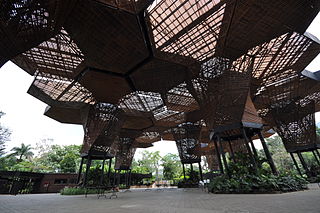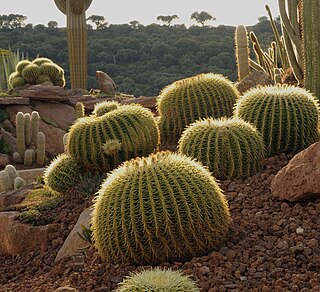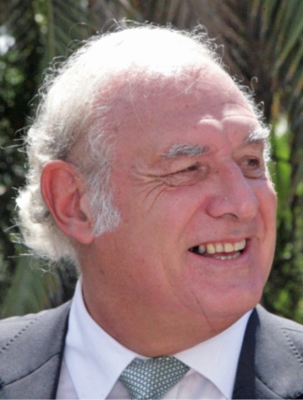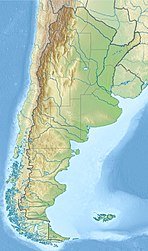
La Rioja is a province of Argentina located in the west of the country. The landscape of the province consist of a series of arid to semi-arid mountain ranges and agricultural valleys in between. It is in one of these valleys that the capital of the province, the city of la La Rioja, lies. Neighboring provinces are from the north clockwise Catamarca, Córdoba, San Luis and San Juan. The dinosaur Riojasaurus is named after the province.

Carlos Thays was a French-Argentine landscape architect, and a student of French landscape architect Édouard André.

The Diaguita people are a group of South American indigenous people native to the Chilean Norte Chico and the Argentine Northwest. Western or Chilean Diaguitas lived mainly in the Transverse Valleys which incised in a semi-arid environment. Eastern or Argentine Diaguitas lived in the provinces of La Rioja and Catamarca and part of the provinces of Salta, San Juan and Tucumán. The term Diaguita was first applied to peoples and archaeological cultures by Ricardo E. Latcham in the early 20th century.

Real Jardín Botánico de Madrid is an 8 hectares botanical garden in Madrid (Spain). The public entrance is located at Plaza de Murillo, next to the Prado Museum.

The José Celestino Mutis botanical garden is Colombia's biggest botanical garden. It serves both as a recreation and research center with an emphasis on Andean and Páramo ecosystems. The garden is located in Bogotá and features plants from every Colombian altitude, climate and region. It was founded in 1955, in honor of botanist and astronomer José Celestino Mutis.
The Jardin botanique "Les Cèdres", often called simply Les Cèdres or the Jardin de la villa "Les Cèdres", is a private botanical garden located at 57 Avenue Denis Séméria, Saint-Jean-Cap-Ferrat, Alpes-Maritimes, Provence-Alpes-Côte d'Azur, France.

The Huntington Desert Garden is part of The Huntington Library, Art Collections and Botanical Gardens in San Marino, California. The Desert Garden is one of the world's largest and oldest collections of cacti, succulents and other desert plants, collected from throughout the world. It contains plants from extreme environments, many of which were acquired by Henry E. Huntington and William Hertrich in trips taken to several countries in North, Central and South America. One of the Huntington's most botanically important gardens, the Desert Garden brought together a group of plants largely unknown and unappreciated in the beginning of the 1900s. Containing a broad category of xerophytes, the Desert Garden grew to preeminence and remains today among the world's finest, with more than 5,000 species in the 10 acre garden.

A cactarium or cactuario is a garden dedicated to the planting of cacti. While they generally specialize in collecting cacti, they can also include other desert plants such as sabla, agaves or Crassulaceae, although this would better be termed "xeriscaping".

Jardín Botánico Canario Viera y Clavijo is the full name of the botanical garden on Gran Canaria, one of the Canary Islands. "Jardín Botánico Canario" means "Botanical Garden of the Canaries", while the additional words "Viera y Clavijo" honor the pioneering Spanish cleric and scholar José Viera y Clavijo (1731–1813), who attempted to found a botanical garden in the Canary Islands in the late eighteenth century.

The Vallarta Botanical Garden is a 79 acres (32 ha) botanical garden at 1,300 ft above sea level, near Puerto Vallarta Mexico. Of which 73 acres (30 ha) are dedicated to preserve.

The Joaquin Antonio Uribe Botanical Garden of Medellín, more simply known as the Botanical Garden of Medellín, is a 14-hectare botanical garden in Medellín, Colombia. The botanical garden has 4,500 flowers and 139 recorded bird species. It has an important collection of orchids preserved in an architectural space called the "Orchideorama".

Mossèn Costa i Llobera Gardens is a botanical garden in the center of Barcelona, Catalonia, Spain. It is situated at the foot of Montjuïc facing the sea. The park owes its name to the renowned Mallorcan poet Miquel Costa i Llobera.

Botanical Garden Atocha-La Liria is a botanical garden located on Avenue Circunvalación, in Ambato, Tungurahua Province, Ecuador. It consists of 14 hectares and dates from 1849.

Quito Botanical Garden is a park, botanical garden, arboretum and greenhouse of 18,600 square meters in the city of Quito, Ecuador. It houses species of plants of the country.

The Jardín Botánico Histórico La Concepción is an landscape garden with over one hundred and fifty years of history. It is located at the northern entrance of the Spanish city of Málaga. This garden is one of the few gardens with subtropical plants that exist in Europe. It has more than fifty thousand plants, of two thousand species of tropical, subtropical, and autochthonous, highlighting the collection with more than one hundred different species of palms, bamboos, aquatic plants and its historical garden.

Desert City is a plant nursery and botanical garden in San Sebastián de los Reyes, near Madrid, Spain, that cultivates and sells xerophytic plants, including cacti, succulents and native plants from the Mediterranean region. It is Europe's largest cactus garden. Desert City was founded by Jacobo García-Germán, an architect, and Mercedes García, a former pharmaceuticals executive.

David Bramwell MBE was an English botanist and taxonomist, director of the Jardín Botánico Canario Viera y Clavijo, Gran Canaria (1974–2012), and active in the conservation of insular floras.

The Cartagena Botanical Garden is located in the hills above Cartagena, in Turbaco, Bolívar, Colombia. It stretches over nine hectares, of which three hectares are natural tropical dry forest and six hectares are dedicated to botanical collections.


















